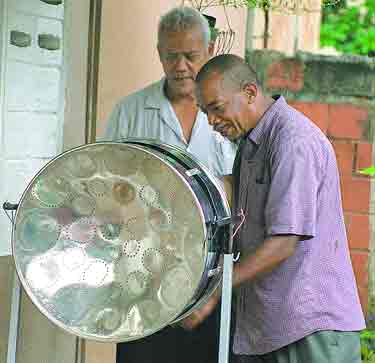|
|
Duo Bore Pan

Eric Lee Wah of Music Equipment Ltd and Denzil Fernandez (right).
October 27, 2001
By Caldeo Sookram Trinidad Express
THE Duo Bore Pan is the latest addition to the steelpan range. It was invented recently by Denzil “Dimes” Fernandez.
From a humble beginning in Belmont and with a track record of 40 years as a researcher, composer, arranger, tuner, performer, lecturer, educator and consultant on the steelpan, Fernandez said he was curious about pan from his boyhood days with the Belmont Symphony steelband in the late 1950s.
His first version of the Bore Pan came out in July 1984. This pan is crafted with holes around the notes instead of the standard groove as contained in most pans.
After receiving the Rudolph Charles Award for his invention of the Bore Pan, Fernandez came up with other steelpan innovations. The U Bass/DenPan, the Panzer, the Bore Reed Pan, the Unision Pan and the Bore-Reed Cello Pan were some of the designs over the years 1987-88.
About his Duo Bore Pan, Fernandez said last Friday: “One pan is tuned from the fourth octave with 29 notes. The other is in B flat from the third octave and contains 21 notes.
“There is need today for more tonal contrast to differentiate tone colour rather than pitch. Pan doesn't have a steady state. Rolling of notes is the only method of sustaining the notes for some time. We must find new techniques to sustain notes longer,” he said.
Fernandez said he used a template as a guide to drill the holes around the notes of the Bore Pans, because these holes were preferable to grooving. Furthermore he said the holes helped in producing clearer notes with a wider tonal range and for longer periods.
This method, he added helped in reducing the size of a musical ensemble and facilitated easy amplification.
The Duo Bore Pans are currently in use at Merle Albino de Coteau’s Music Makers school in Laventille. It’s the only place where musical experiments are conducted on the pans.
There, students Nerissa McCollin and Nyasha De Coteau were happy standing upright and playing merrily along the musical scales of the pans.
“I think it’s interesting. The students are happy with the pans,” says Merle Albino-de Coteau. “It conserves on space and material. I’ll be using the pans at our concert on January 6, 2002 at the Town Hall, Port of Spain.” Fernandez, a resident of Baltimore, USA, has travelled extensively throughout Europe, Japan and USA on steelpan missions.
His first attempt at tuning a pan in 1960 was a failure, he recalled. “I bought a drum and pounded away at the notes but nothing came out.
“Then one day Lauriston McGill of the Belmont Symphony showed me some of the finer techniques in pan tuning. My second attempt was on a Spider Web pan. The notes came out good.”
But he was quick to add: “As you know the Spider Web was the invention of Anthony Williams, not mine. I only tried my hand at that pan.
“Later I joined West Side Symphony. And when Herman “Rock” Johnson, tuner of that band left to go abroad, I ended up tuning the pans. Money was small in them days. They paid me $45 to blend all the pans in the band. But it was a start anyway.”
Today, there are some inquiries about the Duo Bore Pan. “People are interested. Mainly individuals have called. Belmont Fifth Dimension have shown some interest too. There’s a bright future ahead for the Duo Bore Pan,” said Fernandez. Music and Equipment Ltd of 36 Duke Street, Port of Spain, will be handling sales and marketing of the new bore pan.
Previous Page

Archives Steelpan Origins
|


